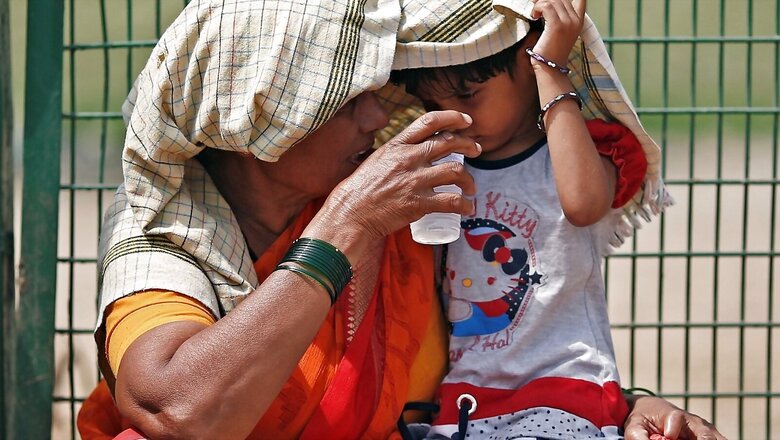
views
As maximum temperatures remain above normal for most parts of the north-western plains, Delhi and the adjoining areas have escaped the searing heatwave so far that has swept parts of West Rajasthan, Gujarat, Maharashtra, Madhya Pradesh, Andhra Pradesh and Telangana.
Dr Rajendra Kumar from the National Weather Forecasting Centre (NWFC) said as of now, there is no heatwave alert for Delhi, Punjab, Haryana and Uttar Pradesh. “The maximum temperature has not gone beyond 36.7 degrees Celsius in Delhi, and it is likely to remain for the next couple of days at least. People are feeling discomfort because of the increase in humidity due to the prevailing easterlies (trade winds). Rather, there was a slight drop in night temperature during the last 24 hours,” he said. On Saturday, the maximum temperatures are hovering around 38 degrees Celsius in Haryana, 37 degrees Celsius in Uttar Pradesh, and 35.7 degrees Celsius in Delhi.
Unlike Delhi, the sweltering weather has taken its toll on Western parts of the country with temperatures breaching the 40 degrees Celsius-mark over most parts of West Rajasthan, including Jaisalmer, Churu, Bikaner, Barmer, and Pilani. A severe heatwave continues over pockets of North-Gujarat, Saurashtra-Kutch, Vidarbha, West Madhya Pradesh, and parts of Andhra Pradesh and Telangana in the south as dry spell lingers on.
The rise in temperatures has also been felt across the hill states of Jammu and Kashmir, Himachal Pradesh and Uttarakhand, with maximum temperatures touching 34 degrees Celsius in some places. “It is definitely warm in Dharamshala, Mandi, parts of Chamba and even Solan, and temperatures have risen, but overall the weather is pleasant. Unlike plains where the temperature has to touch 40 degrees Celsius for a heatwave to be declared, it can be announced in hill stations after it crosses 30 degrees Celsius,” said another IMD scientist.
Easterlies & MJO : What causes the temperatures to rise?
The India Meteorological Department (IMD) said it had forecasted normal to above normal minimum temperatures in March in its seasonal outlook for March-April-May – especially over many parts of northwest India, west and some parts of central India, the east coastal region and some areas along the foothills of the Himalayas. “We expected the temperatures to rise March onwards. The 500mb (upper air chart) clearly showed the development of an anti-cyclone in the central part of India. It’s a system that usually forms in the upper atmosphere at the beginning of March and alters the wind pattern. It pushes a lot of air downwards, leading to warmer temperatures near the ground,” explained Dr K S Hosalikar, Head, climate research and services, IMD Pune.
While it is normal for the plains to experience higher temperatures, the heat wave in the coastal area has surprised many. Mumbai, for instance, recorded temperatures close to 40 degrees Celsius in the past few days. According to scientists, this is because of the domination of easterlies (trade winds) and largely due to a system called the Madden Julian Oscillation (MJO), which is also pressing hard in Phase 3.
“The MJO is forming a sort of ridge – an obstruction for the sea breeze to reach the coast, hence delaying it. When the sea breeze gets delayed over the Mumbai-Konkan region, the temperature tends to rise. In Mumbai, the sea breeze time is normally around 11:30 am-12 noon. But, there are days when the sea breeze got delayed up to 3-4 pm, and the temperatures shoot up to 37-38 degrees Celsius even 40 degrees Celsius when the sea breeze did not set at all during the day. During that time, the north easterlies prevail, and they shoot up the temperature for the coastal region as well,” shared K S Hosalikar Head, climate research and services, IMD Pune.
While heat waves have been witnessed in the coastal areas like the Konkan belt, they aren’t usual, or as frequent as they are in the central parts of India. They are also not as severe, or risky as they are in the central plains, because of the moisture content in the air.
Heat wave to abate from 20 March onwards
In a piece of good news, the India Meteorological Department (IMD) has said the current weather conditions indicate a falling tendency of temperatures throughout the country. This trend is likely to cause abatement in heat wave conditions from most of the affected regions from March 20. However, certain pockets of West Rajasthan, Vidarbha, West Madhya Pradesh and Gujarat are likely to continue bearing the brunt of the heatwave for at least the next 2-3 days with no respite from the rising temperature.
Read all the Latest News India and Breaking News here




















Comments
0 comment